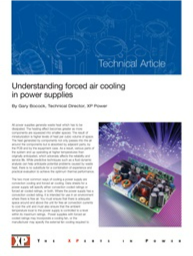Understanding forced air cooling in power supplies
All power supplies generate waste heat which has to be dissipated. The heating effect becomes greater as more components are squeezed into smaller spaces. The result of miniaturization is higher levels of heat per cubic volume of space.
The heat generated by components not only passes into the air around the components but is absorbed by adjacent parts, by the PCB and by the equipment case. As a result, various parts of the system end up operating at higher temperatures than originally anticipated, which adversely affects the reliability and service life.
Download this whitepaper to learn more.
Read More
By submitting this form you agree to XP Power contacting you with marketing-related emails or by telephone. You may unsubscribe at any time. XP Power web sites and communications are subject to their Privacy Notice.
By requesting this resource you agree to our terms of use. All data is protected by our Privacy Notice. If you have any further questions please email dataprotection@techpublishhub.com
Related Categories: Capacitors, Components, cooling, Power


More resources from XP Power

Understanding forced air cooling in power supplies
All power supplies generate waste heat which has to be dissipated. The heating effect becomes greater as more components are squeezed into smaller ...

Understanding AC/DC power supply efficiency – the hot topic
The drive for smaller power supplies goes handin hand with a need for greater efficiency. There' s a direct relationship here because the smaller t...

95% High efficiency power supply changes the way high reliability systems are designed
The size or power density of a power supply is a key criteria when selecting the optimum product for a given application. In applications where fan...
